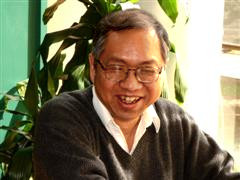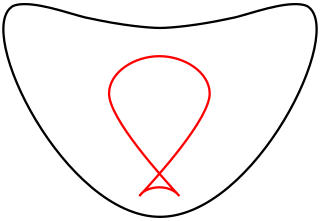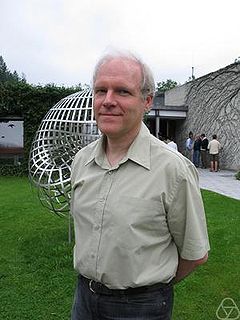
Vladimir Igorevich Arnold was a Soviet and Russian mathematician. While he is best known for the Kolmogorov–Arnold–Moser theorem regarding the stability of integrable systems, he made important contributions in several areas including dynamical systems theory, algebra, catastrophe theory, topology, algebraic geometry, symplectic geometry, differential equations, classical mechanics, hydrodynamics and singularity theory, including posing the ADE classification problem, since his first main result—the solution of Hilbert's thirteenth problem in 1957 at the age of 19. He co-founded two new branches of mathematics—KAM theory, and topological Galois theory.

Shing-Tung Yau is an American mathematician and the William Caspar Graustein Professor of Mathematics at Harvard University.
In geometry, a hypersurface is a generalization of the concepts of hyperplane, plane curve, and surface. A hypersurface is a manifold or an algebraic variety of dimension n − 1, which is embedded in an ambient space of dimension n, generally a Euclidean space, an affine space or a projective space. Hypersurfaces share, with surfaces in a three-dimensional space, the property of being defined by a single implicit equation, at least locally, and sometimes globally.

In mathematics, a cubic surface is a surface in 3-dimensional space defined by one polynomial equation of degree 3. Cubic surfaces are fundamental examples in algebraic geometry. The theory is simplified by working in projective space rather than affine space, and so cubic surfaces are generally considered in projective 3-space . The theory also becomes more uniform by focusing on surfaces over the complex numbers rather than the real numbers; note that a complex surface has real dimension 4. A simple example is the Fermat cubic surface
In mathematics, a del Pezzo surface or Fano surface is a two-dimensional Fano variety, in other words a non-singular projective algebraic surface with ample anticanonical divisor class. They are in some sense the opposite of surfaces of general type, which have ample canonical class.
In number theory and algebraic geometry, a rational point of an algebraic variety is a point whose coordinates belong to a given field. If the field is not mentioned, the field of rational numbers is generally understood. If the field is the field of real numbers, a rational point is more commonly called a real point.
In algebraic geometry, a Fano variety, introduced by Gino Fano in, is a complete variety X whose anticanonical bundle KX* is ample. In this definition, one could assume that X is smooth over a field, but the minimal model program has also led to the study of Fano varieties with various types of singularities, such as terminal or klt singularities.

In projective geometry, a dual curve of a given plane curve C is a curve in the dual projective plane consisting of the set of lines tangent to C. There is a map from a curve to its dual, sending each point to the point dual to its tangent line. If C is algebraic then so is its dual and the degree of the dual is known as the class of the original curve. The equation of the dual of C, given in line coordinates, is known as the tangential equation of C.
In mathematics, vanishing cycles are studied in singularity theory and other parts of algebraic geometry. They are those homology cycles of a smooth fiber in a family which vanish in the singular fiber.

In algebraic geometry, a Sarti surface is a degree-12 nodal surface with 600 nodes, found by Alessandra Sarti (2008). The maximal possible number of nodes of a degree-12 surface is not known, though Yoichi Miyaoka showed that it is at most 645.
In mathematics and especially complex geometry, the Kobayashi metric is a pseudometric intrinsically associated to any complex manifold. It was introduced by Shoshichi Kobayashi in 1967. Kobayashi hyperbolic manifolds are an important class of complex manifolds, defined by the property that the Kobayashi pseudometric is a metric. Kobayashi hyperbolicity of a complex manifold X implies that every holomorphic map from the complex line C to X is constant.

In algebraic geometry, an Endrass surface is a nodal surface of degree 8 with 168 real nodes, found by Stephan Endrass (1997). As of 2007, it remained the record-holder for the most number of real nodes for its degree; however, the best proven upper bound, 174, does not match the lower bound given by this surface.
The terminology of algebraic geometry changed drastically during the twentieth century, with the introduction of the general methods, initiated by David Hilbert and the Italian school of algebraic geometry in the beginning of the century, and later formalized by André Weil, Jean-Pierre Serre and Alexander Grothendieck. Much of the classical terminology, mainly based on case study, was simply abandoned, with the result that books and papers written before this time can be hard to read. This article lists some of this classical terminology, and describes some of the changes in conventions.

Gerhard Huisken is a German mathematician whose research concerns differential geometry and partial differential equations. He is known for foundational contributions to the theory of the mean curvature flow, including Huisken's monotonicity formula, which is named after him. With Tom Ilmanen, he proved a version of the Riemannian Penrose inequality, which is a special case of the more general Penrose conjecture in general relativity.

In geometry, a quadrisecant or quadrisecant line of a curve is a line that passes through four points of the curve. Every knotted curve in three-dimensional Euclidean space has a quadrisecant. The number of quadrisecants of an algebraic curve in complex projective space can be computed by a formula derived by Arthur Cayley. Quadrisecants of skew lines are also associated with ruled surfaces and the Schläfli double six configuration.

Alexander Nikolaevich Varchenko is a Soviet and Russian mathematician working in geometry, topology, combinatorics and mathematical physics.
In algebraic geometry, a nodal surface is a surface in projective space whose only singularities are nodes. A major problem about them is to find the maximum number of nodes of a nodal surface of given degree.
In enumerative geometry, Steiner's conic problem is the problem of finding the number of smooth conics tangent to five given conics in the plane in general position. If the problem is considered in the complex projective plane CP2, the correct solution is 3264. The problem is named after Jakob Steiner who first posed it and who gave an incorrect solution in 1848.

Jean-Pierre Demailly is a French mathematician working in complex analysis and differential geometry.










